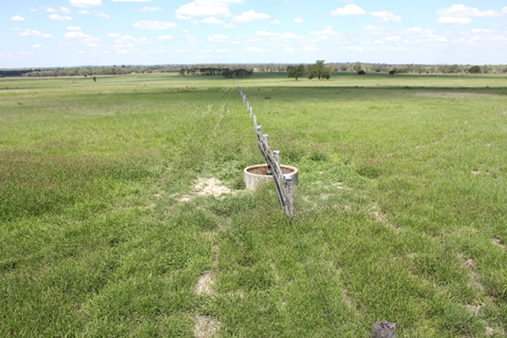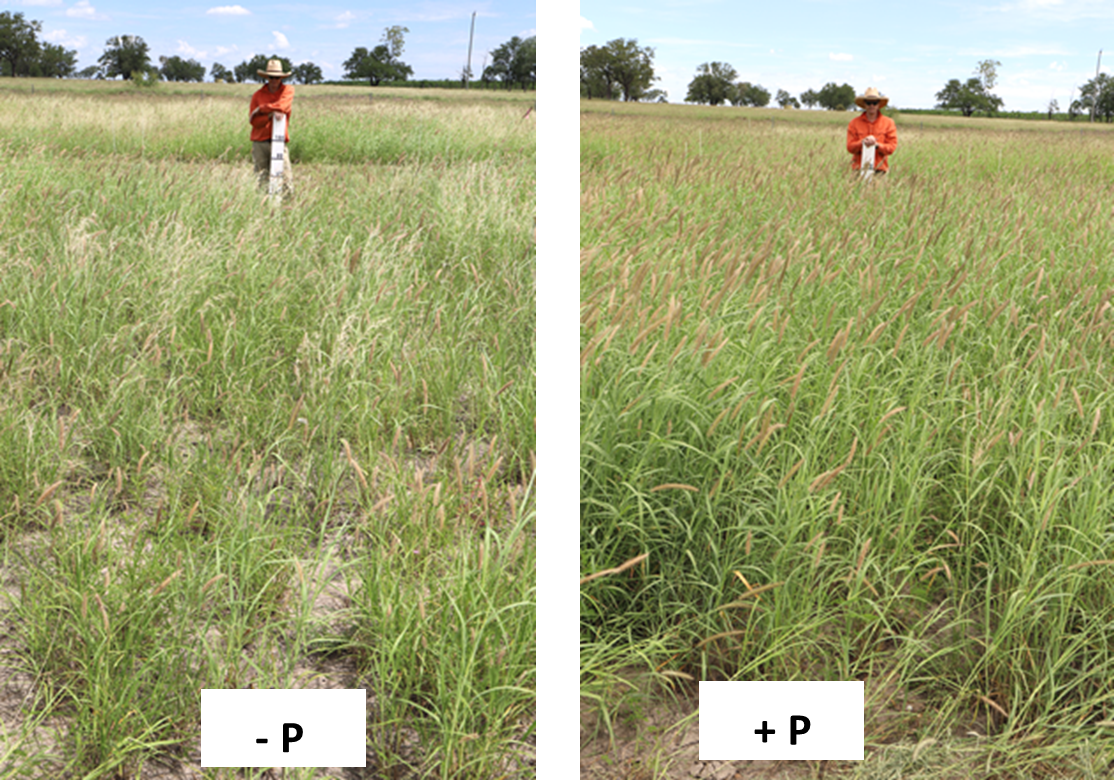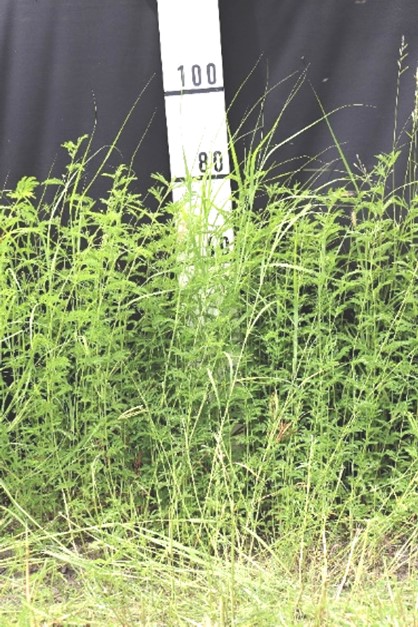Beef production benefits of legumes in a grazing trial at Wandoan
In 1995, near Wandoan, Queensland, two pasture paddocks were sown side-by-side: one sown with buffel grass and desmanthus legume and the other sown with buffel grass only. Pasture and animal production was measured for the first five years after establishment, and again in 2011-2013, more than 15 years after planting. Pasture production was increased where the desmanthus legume was included. In addition, phosphorus fertiliser was applied to part of the legume-grass paddock and increased pasture production further.
| Names: | Alan and Karen Postle |
| Property: | ‘Kookaburra’, Wandoan, Queensland |
| Existing pastures: | ‘Biloela’ and ‘Gayndah’ buffel grass, ‘Bisset’ creeping bluegrass, Queensland bluegrass and ‘Jaribu’ desmanthus. The rest of the property is mainly buffel grass with some Caatinga stylo and native grass species. |
| Soil types: | Grey clay soils |
| Enterprise: | Beef cattle |
| Grazing trial area | 20 ha |
Two paddocks, long-term results
Adding a legume such as desmanthus to a grass pasture system can produce a significant increase in pasture production, compared to grass-only pastures.
At a beef cattle enterprise north of Wandoan two paddocks were sown in 1995 to compare the grazing productivity of grass-only pastures with legume-grass pastures.
More than 15 years later, the increase in pasture growth and liveweight gain in the legume-grass paddock continues to sustain higher beef production, demonstrating long-term benefits from incorporating a productive, persistent legume into grass pastures.

Both paddocks were ex-cropping, cultivated paddocks located side-by-side. One was sown with ‘Biloela’ buffel grass with a small amount of ‘Bisset’ creeping bluegrass, and the other was sown with the same grasses plus the legume ‘Jaribu’ desmanthus. Each paddock was 10 ha in size, and the soils were very low in phosphorous.
Early observations
Pasture and animal production was measured in the first five years after planting, but during this time there was no benefit from incorporating legume into the pastures, compared to the grass-only pasture.
This result is common for newly established tropical pastures. Good nitrogen (N) levels in the soil after fallowing provides pastures with ideal conditions to establish, using the N in the soil.
Long-term success
Despite no difference observed in the first few years between the two paddocks, data was again collected from the same paddocks between 2011 and 2013, more than 15 years later.
Measurements collected include pasture composition (which species), dry matter production, feed quality and cattle liveweight gain.
These measurements were collected the year after an extraordinarily good season in 2010-11 which produced plenty of pasture growth.

The legume-grass pastures produced more than double the pasture yield than the grass-only pasture each year. In the 2011-12 summer, the legume-grass pasture produced 3,105 kg/ha dry matter compared to 1,144 kg/ha in the grass-only pasture.

The legume-grass pastures showed a significant improvement in pasture species composition, with a lower population of weeds and undesirable grasses than the grass-only pasture.
Better liveweight gains from legumes
In addition to the improvement in pasture production, the legume-grass pasture had 65% more cattle liveweight gain compared to the grass-only pasture. Specifically, during one growing season between February to May 2013, the legume-grass pasture produced a 0.4 kg/head/day gain over the grass-only pasture. Over four months, that equates to around 48kg gained by grazing legume-grass pastures.
Fixing a P deficiency
Despite the apparent good pasture condition, cattle at Kookaburra had unexpected poor growth. Blood tests found that the cattle were deficient in phosphorus and marginally deficient in copper. The next draft of cattle in the trial were fed a phosphorus (P) supplement and rumen copper pellet which supported much higher liveweight gains in the second year.
At the same time, the soil at in the paddocks was sampled, tested and measured very low in P. The soils measured less than 5 mg/kg Colwell P in the top 10 cm of soil (compared to 15 – 25 mg/kg for ideal pasture legume production depending on the species). Legumes fix more N when they produce more dry matter; and to produce more dry matter, legumes require good nutrition, especially P and sulphur (S).
To look into it further, a small section of the legume-grass paddock was fenced off and treated with different rates of P fertiliser. The fertiliser was drilled into the small area of pasture in September 2012 using a tyned implement.

Pasture dry matter production has been measured since the application of P fertiliser to the legume-grass paddock. P fertiliser increased the pasture dry matter production by 40%.

Eight years after the P fertiliser was applied, the legume-grass pastures still produced twice as much dry matter with P fertiliser than without.
By early 2020 (Fig. 6), grass had become the dominant proportion of the dry matter produced. The increase in grass suggests that the P fertiliser initially increased the legume growth, which produced more N fixation. The N fixed by the legumes cycled back and increased grass growth. Eventually, the grasses will need more N and the legumes dry matter production will increase again.

‘We’ve noticed the benefits’
Kookaburra owners, Alan and Karen Postle have been participating in this research over the years and have noticed the benefits.
‘Weight gain on the cattle that grazed the paddock with the legumes was well and truly above that of the cattle that grazed the paddock without legumes.’ Alan shared.
He’s also noticed the increased pasture growth in the fenced off P trial in his paddock.
‘It’s growing tall,’ he said, ’there’s plenty of desmanthus (outside the fenced P trial area), but it’s only short. Inside (where the P was applied) the desmanthus is growing tall, and there is plenty of grass.’
The bottom line: legumes can increase production
There are multiple production benefits to using persistent, long-term legume-based pastures:
- legumes fix nitrogen (N) from the atmosphere that results in higher protein in the diet for livestock, and more pasture production
- better pasture composition, with fewer undesirable species
- higher dry matter production with legume-grass pastures
- potential for further increases with the application of phosphorus (P) fertilisers (if needed)
- more groundcover providing better protection from erosion, and improved capture of rainfall
- higher animal liveweight gain from more and better-quality pastures
- increased long-term sustainability.

Acknowledgement
The Legume BMP in the Brigalow Belt project is joint funded through Meat and Livestock Australia and Department of Agriculture and Fisheries.
© State of Queensland Department of Agriculture and Fisheries). Published 2022.
Compiled by Scott Bloomfield and Louise Walker.
More information
Legume species information: Queensland Department of Agriculture and Fisheries https://www.daf.qld.gov.au/business-priorities/agriculture/plants/crops-pastures/pastures/
Peck, G. A., Chudleigh, F., Guppy, C., Johnson, B., & Lawrence, D N. (2015). Use of phosphorus fertiliser for increased productivity of legume-based sown pastures in the Brigalow Belt region – a review. Sydney, Australia: Meat and Livestock Australia Limited.
Jackson D., Rolfe J., English B., Holmes B., Matthews R., Dixon R., Smith P., MacDonald N. (2012). Phosphorus management of beef cattle in northern Australia, Meat and Livestock Australia limited.